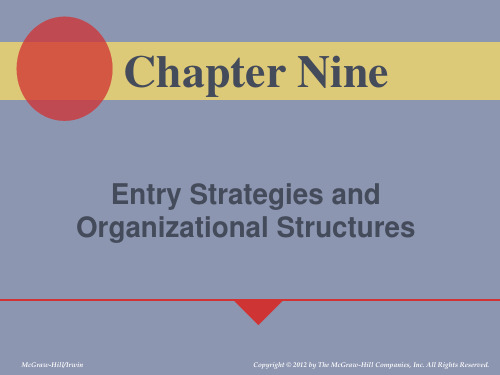跨国公司与直接投资Chap009.ppt
合集下载
第二章 跨国公司的对外直接投资《跨国公司经营与管理》PPT课件

第
三
生活服务设施。
节
对
影响:基础设施状况是投资者选择投资国和投资区
外 直
接
域的最重要因素之一。优质的基础设施条件必然是
投
资
吸引外国投资者最好的资本。
的 影
响
因
素
3. 经济政策
含义:它主要是指东道国政府为实现其社会经济发
展目标而采用的一系列政策,体现了东道国政府对
第
待外资的态度和管理方法;
三 节
直 接
投
山路也会使同样的距离要多走上几倍路途,况且山路的 资
的
风险不仅要大于平路,而且汽车在爬山时的耗油量要远
影 响
远多于走平坦的公路;
因 素
地形复杂的国家或地区往往会使投资者望而却步。
3.气候
含义:主要研究气温、日照、降雨量、风暴以及台
风等;
第
三
影响1:气候的差异和变化影响企业的生产、运输,
joint venture),一种合伙制企业。
合资企业与合作经营企业明显差异
合资企业
合作经营企业
具有统一的组织管理机构,管理 组织结构松散,没有一个统一的
组织管理模式 方式通常实行的是董事会领导下 组织管理机构,管理方式比较灵
的总经理负责制
活
第 一
节 各投资者有明确的股权比例安排,没有安排股权比例,各投资方的 对
直 接
投
独立地完成产品的全部生产和销售过程。一般运用于
资
概
机械制造业和食品加工业。
述
垂直型投资(vertical investment)也称纵向性投
资,是指一国企业到国外建立与国内的产品生产有
关联的子公司,并在母公司与子公司之间实行专业
第六章 国际直接投资与跨国公司PPT课件

按照投资者是否建立新企业可分为创建新企业与控 制现有国外企业两类。
按照投资者控制被投资企业产权的程度可分为独资 经营、合资经营、合作经营和合作开发等
按照投资主体与其投资企业之间国际分工的方式,
可以把国际直接投资分为水平型投资、垂直型投资
和混合型投资。 2020/11/10
6
三、战后国际直接投资的发展
第三篇: 世界经济的运行与协调
2020/11/10
1
主要内容
第一节 国际直接投资及其发展 第二节 跨国公司及其经营策略
2020/11/10
2
第一节 国际直接投资及其发展
资本运动过程中的三种形态
货币资本
生产资本
商品资本
国际间接投资
国际直接投资
国际贸易
2020/11/10
3
第一节 国际直接投资及其发展
美国
1990 23.2
1995 51.8
2000 62.0
法国
38.6
34.6
86.6
日本
68.7
58.9
73.8
英国
46.8
50.0
83.6
德国
39.6
56.5
51.7
意大利
78.9
62.1
52.1
加拿大
39.8
53.8
65.3
资料来源:联合国贸发会议(UNCTAD),http://。
2020/11/10
一、国际直接投资的含义 (International Direct Investment)
FDI(Foreign Direct Investment) 是指投资者为了在国外获得长期的投资
效益并得到对企业的控制权,通过直接建立 新的企业、公司或并购原有企业等方式进行 的国际投资活动。P178
国际直接投资与跨国公司幻灯片PPT

本章结构图
关键性问题
1. 了解国际直接投资的内部化理论和生产折 衷理论。
2. 了解各种国际生产方式的选择。
第一节 企业优势、交易成本及内部化
一、垄断优势的获得和实现
• 对某种技术的垄断 • 产业组织形式的寡占特点 • 企业家才能或管理能力的“过剩” • 具备获取廉价的原材料和资金的渠道
二、市场交易内部化
国际直接投资与跨国公司 幻灯片PPT
本课件PPT仅供大家学习使用 学习完请自行删除,谢谢! 本课件PPT仅供大家学习使用 学习完请自行删除,谢谢!
本章简介
在这一章中,概要地介绍了国际直接投资的基本原理, 以便为大家进一步学习有关理论和理解实践中的相关问题, 提供一个可供参考的线索。
总的来说,企业特有优势的形成与其所处的区位和行 业结构特点有关,但要维持一种所有权优势需要以市场不 完全为前提。市场的不完全也使企业以内部化的方式实现 其优势成为必要。内部化的过程有利于减少交易成本,这 为分工的发展提供了新的余地。内部化过程超越了国界, 便产生了跨国公司和以直接投资为主要推动力量的生产国 际化进程。跨国公司的国际扩展过程和格局是由所有权优 势、内部化优势和区位优势在相互作用中共同决定的。跨 国公司对国际生产的协调,使国际分工进入了一个新的时 期。企业的跨国经营活动既是国际分工发展的必然结果, 也是促进国际分工不断深化的重要力量。
• 市场的不完全性导致许多交易无法通过外部市场 达成,或即使达成也要承担较高的交易成本。
• 交易成本,Leabharlann 狭义上说是指通过市场进行交易时 必须付出的代价。
• 如果企业内部组织交易的成本低于市场交易成本, 就可能会出现“市场交易的内部化”过程。
• 内部化的过程有利于减少交易成本,这为分工的 发展提供了新的余地。内部化过程超越国界,便 产生了跨国公司和以直接投资为主要推动力量的 生产国际化进程。
第六章跨国公司与国际直接投资PPT课件

2 网络分布指数,这个指数是用以反映公司经营所 涉及的东道国的数量。
网络分布指数=N/N**100%
N-公司国外分支机构所在的国家数;
N*—公司有可能建立国外分支机构的国家数,即世 界上有FDI输入的国家数,实际运算中,从已接收 FDI输入存量的国家数目中减去1(排除母国)即 可得出N*;根据《世界投资报告,1997》提供的 数据N*=178
2020/8/7
1
整体概况
概况一
点击此处输入 相关文本内容
01
概况二
点击此处输入 相关文本内容
02
概况三
点击此处输入 相关文本内容
03
国际投资主体
私人投资主体 官方投资主体
跨国公司 跨国金融机构 官方和半官方机构
国际直接投资主体 国际间接投资主体
2020/8/7
3
第一节 跨国公司的产生及其发展
3 所有权标准上的界定 ❖ 反映对国外分支机构控制权的股权比重:
一般标准10% ❖ 自身股权的多国性:无国籍性 4 经营管理特征上的界定 ❖ 全球经营概念 ❖ 一体化经营战略
2020/8/7
5
一、跨国公司的内涵 (一)跨国公司的概念界定
4 综合界定:跨国公司就是指具有全球性经营 动机和一体化的经营战略,在多个国家拥有 从事生产经营活动的分支机构,并将它们置 于统一的全球性经营计划之下的大型企业。
2020/8/7
8
一、跨国公司的内涵 (二)跨国公司国际化经营程度的度量
3 外向程度比率(OSR)
OSR=一个行业或厂商的海外产量(或资产、 销售、雇员数)/一个行业或厂商在其母国 的产量(或资产、销售、雇员数)
2020/8/7
9
一、跨国公司的内涵 (二)跨国公司国际化经营程度的度量
跨国公司与直接投资Chap009.ppt

Organizational Expectations of Internationalization
Basic Organizational Structures Initial Division Structure
Initial Division Structures Export arrangement Common among manufacturing firms, especially those with technologically advanced products On-site manufacturing operations In response to local governments when sales increase Need to reduce transportation costs Subsidiary Common for finance-related businesses or other operations that require onsite presence from start
Entry Strategies and Ownership Structures Export/Import
Exporting and importing are often the only available choices for small and new firms wanting to go international Also permits larger firms to begin international expansion with minimum investment and minimum risk Permits easy access to overseas markets Paperwork can be turned over to export management company or handled through the firm’s export department Strategy is usually transitional in nature
Basic Organizational Structures Initial Division Structure
Initial Division Structures Export arrangement Common among manufacturing firms, especially those with technologically advanced products On-site manufacturing operations In response to local governments when sales increase Need to reduce transportation costs Subsidiary Common for finance-related businesses or other operations that require onsite presence from start
Entry Strategies and Ownership Structures Export/Import
Exporting and importing are often the only available choices for small and new firms wanting to go international Also permits larger firms to begin international expansion with minimum investment and minimum risk Permits easy access to overseas markets Paperwork can be turned over to export management company or handled through the firm’s export department Strategy is usually transitional in nature
国际直接投资与跨国公司PPT课件

垄断优势理论 公司内部化理论
❖ 出口、投资与许可证
❖ 国际生产综合论
当前居于主导地位的跨国公司理论
20.04.2020
.
5
第一节 企业优势、交易成本及内部化
❖ 现代跨国公司理论的出现,首先是为了解释 战后美国企业的对外投资行为,特别是对西 欧的投资
❖ 研究跨国公司相对于当地企业的特有优势 (即垄断优势),是国际直接投资和跨国公 司理论的一个出发点
可见,跨国公司以对外直接投资为向外 扩张的主要手段
20.04.2020
.
2
◎引言
❖ 跨国公司理论,又称为国际直接投资理论
❖ 解释跨国公司的产生、发展和利益的理论
❖ 主流跨国公司理论是以西方大型跨国公司 为参照,重点探究跨国公司海外投资行为 的发生机理
❖ 跨国公司与国际贸易关系密不可分,前者 属于投资领域,后者属于贸易领域
另一类交易成本是签订契约,以及监督和执 行契约所花费的成本。
❖ 企业作为生产的一种组织形式,在一定程 度上是对市场的一种替代
不确定性
交
不完全
导致
易
信息
信息不对称
成
本
20.04.2020
.
市场 与企 业的 并存
16
☆交易成本理论
❖ 企业作为生产的一种组织形式,在一定程 度上是对市场的一种替代
❖ 由于外部市场的不完全性(外部性、垄断 过强),市场交易是有一定成本的,而市 场内部化是一种提高效率的有效方法
20.04.2020
.
13
二、市场交易内部化
❖ 代表人物:
巴克莱、卡森
《跨国公司的未来》(1976) 《国际经营理论》(1978)
❖ 建立在交易成本学说基础上的内部化理论, 被认为是解释跨国企业的形成和对外直接 投资发生机理的核心原理
跨国公司概述与国际直接投资政策课件

跨国公司概述与国际直接投资政 策课件
• 跨国公司概述 • 国际直接投资理论 • 国际直接投资政策 • 案例分析与讨论
01
跨国公司概述
跨国公司的定义与特点
定义:跨国公司是指在一个以上国家或 地区设立分支机构或子公司,并从事跨 国经营活动的企业。
资本实力雄厚:跨国公司通常具有强大 的资金实力和融资能力,以支持其全球 化经营战略。
中国的开放政策和投资环境改 善也为该跨国公司的投资提供 了支持和保障。
案例二
外资政策调整 经济影响 社会影响
挑战与风险
该发展中国家在近年来对外资政策进行了调整,包括放宽外资 准入限制、提高外资持股比例上限等,旨在吸引更多外资流入
。
外资政策的调整对该国经济产生了积极影响,包括促进经济增 长、增加就业机会、提升产业技术等。
外资企业的进入也带来了社会变革,包括提高本地企业的竞争 力、推动本土品牌的发展等。
然而,外资的引入也带来一些挑战和风险,如国内企业受到冲 击、资源环境压力增大等,需要引起关注。
案例三
全球化背景
随着全球化的加速推进,该欧洲 跨国公司面临着全球范围内的竞
争和合作机会。
战略调整
为了适应全球化趋势,该跨国公司 进行了战略调整,包括拓展新兴市 场、加强研发创新、推动数字化转 型等。
形式
国际直接投资的形式包括股权投资、合资企业、独资企业等。其中,股权投资是 指投资者购买外国企业的股份,合资企业是指两个或多个国家或地区的企业共同 出资组建企业,独资企业是指投资者在外国单独出资建立企业。
国际直接投资的经典理论
垄断优势理论
该理论认为,跨国公司进行国际直接投资是因为它们拥有 独特的垄断优势,如技术、品牌、管理等,这些优势可以 帮助它们在国外市场中获得竞争优势。
• 跨国公司概述 • 国际直接投资理论 • 国际直接投资政策 • 案例分析与讨论
01
跨国公司概述
跨国公司的定义与特点
定义:跨国公司是指在一个以上国家或 地区设立分支机构或子公司,并从事跨 国经营活动的企业。
资本实力雄厚:跨国公司通常具有强大 的资金实力和融资能力,以支持其全球 化经营战略。
中国的开放政策和投资环境改 善也为该跨国公司的投资提供 了支持和保障。
案例二
外资政策调整 经济影响 社会影响
挑战与风险
该发展中国家在近年来对外资政策进行了调整,包括放宽外资 准入限制、提高外资持股比例上限等,旨在吸引更多外资流入
。
外资政策的调整对该国经济产生了积极影响,包括促进经济增 长、增加就业机会、提升产业技术等。
外资企业的进入也带来了社会变革,包括提高本地企业的竞争 力、推动本土品牌的发展等。
然而,外资的引入也带来一些挑战和风险,如国内企业受到冲 击、资源环境压力增大等,需要引起关注。
案例三
全球化背景
随着全球化的加速推进,该欧洲 跨国公司面临着全球范围内的竞
争和合作机会。
战略调整
为了适应全球化趋势,该跨国公司 进行了战略调整,包括拓展新兴市 场、加强研发创新、推动数字化转 型等。
形式
国际直接投资的形式包括股权投资、合资企业、独资企业等。其中,股权投资是 指投资者购买外国企业的股份,合资企业是指两个或多个国家或地区的企业共同 出资组建企业,独资企业是指投资者在外国单独出资建立企业。
国际直接投资的经典理论
垄断优势理论
该理论认为,跨国公司进行国际直接投资是因为它们拥有 独特的垄断优势,如技术、品牌、管理等,这些优势可以 帮助它们在国外市场中获得竞争优势。
跨国公司及直接投资理论(PPT 79页)

❖ 2003年大众汽车在中国的销量首次接近70万 辆大关, 占据30%左右的市场份额 , 远远超过 了大众汽车在德国本土60万辆左右的销量。
第二节 跨国公司发展概论
➢ 1902年,英国油脂和肥皂业巨头莱佛公司感到 其产品对荷兰、比利时出口关税太高,为避开这 种限制, 就到当地进行直接投资。
➢ 美国的威斯汀豪斯空气刹车公司到法国设厂, 也是为了避开法国铁路公司规定的空气刹车必 须由当地厂商供应的限制。
第二节 跨国公司发展概论
二战后跨国公司的发展 ●美国利用战争期间发展起来的新兴军事科技, 应用到民用部门, 在国内发展了一系列新兴制 造工业部门, 如电子、飞机制造, 计算机、汽车、 化学、机械、石油化工等。
●美日欧跨国公司从事服务业增长到60%,制造 业占36%,初级产业5%。
• 戴姆勒—奔驰公司与克莱斯勒公司双方的董事 长在第一次会谈中仅用了17分钟就达成了并购 意向, 数月之后就完成了合并。
• 前克莱斯勒公司的董事长伊顿曾坦言,尽管该公 司拥有足够的资金, 但没有足够的管理能力以 尽快实现其雄心勃勃的海外扩张目标, 并缺乏 进行扩张的其他资源,因此必须在美国以外寻找 一个合作伙伴, 而与戴姆勒—奔驰公司合并后 则可以利用其管理资源和其他资源向国际市场 渗透。这种合并能达到双赢的目的。
发业和种植业为主 ●加工制造型跨国公司主要从事最终产品和中间
产品的制造,如金属制品、钢材、机械、运输 设备和电信设备等 ●服务型跨国公司是指从事贸易、金融、运输、 通讯、旅游、房地产、保险、广告、管理咨询、 会计法律服务、信息等行业和领域非物质产品 生产,提供各种服务的跨国公司
跨国公司的类型
(三)按公司内部的经营结构划分
第一节 跨国公司概览
(二)业绩标准(Performance Characteristics Cr iteria)
第二节 跨国公司发展概论
➢ 1902年,英国油脂和肥皂业巨头莱佛公司感到 其产品对荷兰、比利时出口关税太高,为避开这 种限制, 就到当地进行直接投资。
➢ 美国的威斯汀豪斯空气刹车公司到法国设厂, 也是为了避开法国铁路公司规定的空气刹车必 须由当地厂商供应的限制。
第二节 跨国公司发展概论
二战后跨国公司的发展 ●美国利用战争期间发展起来的新兴军事科技, 应用到民用部门, 在国内发展了一系列新兴制 造工业部门, 如电子、飞机制造, 计算机、汽车、 化学、机械、石油化工等。
●美日欧跨国公司从事服务业增长到60%,制造 业占36%,初级产业5%。
• 戴姆勒—奔驰公司与克莱斯勒公司双方的董事 长在第一次会谈中仅用了17分钟就达成了并购 意向, 数月之后就完成了合并。
• 前克莱斯勒公司的董事长伊顿曾坦言,尽管该公 司拥有足够的资金, 但没有足够的管理能力以 尽快实现其雄心勃勃的海外扩张目标, 并缺乏 进行扩张的其他资源,因此必须在美国以外寻找 一个合作伙伴, 而与戴姆勒—奔驰公司合并后 则可以利用其管理资源和其他资源向国际市场 渗透。这种合并能达到双赢的目的。
发业和种植业为主 ●加工制造型跨国公司主要从事最终产品和中间
产品的制造,如金属制品、钢材、机械、运输 设备和电信设备等 ●服务型跨国公司是指从事贸易、金融、运输、 通讯、旅游、房地产、保险、广告、管理咨询、 会计法律服务、信息等行业和领域非物质产品 生产,提供各种服务的跨国公司
跨国公司的类型
(三)按公司内部的经营结构划分
第一节 跨国公司概览
(二)业绩标准(Performance Characteristics Cr iteria)
跨国公司与直接投资(ppt 33页)

四是跨国公司海外分支雇佣人数在危机后快速增长。 2011 年达到 6906.5万人,比2005-2007年均值增 长了 33.9%。
全球跨国公司发展极不均衡
少数大型跨国公司在全球经济中占据重要地位:
全球有约 8 万家跨国公司,仅规模前 100 家非金融跨国公司在 2010 年的全球生产带来的增值就达到 16 万亿美元,占全球 GDP 的1/4,海外分支产值占全球 GDP10%以上和世界出口总额 1/3。
第二次世界大战以后,美国公司在这方面发挥了领 导性的作用,西欧国家以及日本公司在这方面也取 得了巨大的发展。到2008年,全世界跨国公司的总 数8.2万家,它们在世界各地的分支机构超过了81 万家。
2013年财富世界500强排行榜,包含台湾在内的中国 上榜的公司总数达95家。中国上榜企业的总收入达5.2万 亿美元,占500强企业总收入的17%。
二是跨国公司借危机大幅海外注资。2009-2011年全球 跨国公司海外分支总资产为77.5 万亿美元,比20052007年均值逆势大幅增长77.7%,2011 年达 82.1 万亿 美元。
三是跨国公司海外分支为全球创造价值的作用稳中 增强。2005-2007年,跨国公司海外分支销售额均 值占全球 GDP 均值比重为 40.2%,2009-2011年分 别为 41.2%、40.6%和 40.0%。
2011 年,这100家跨国公司对外投资项目价值为 3700 亿美元, 占全球外国直接投资流入量约 1/4;跨国并购额为 1940 亿美元, 占全球跨国并购额 36%;绿地投资额为1800 亿美元,占全球绿地 投资额 20%;国内外共雇佣 1538 万人,是所有跨国公司海外分 支雇佣人数的约 1/4。
2013年财富世界500强排行榜新上榜的31家公司中, 中国公司占据了18个席位,占新上榜公司总数的60%左 右,中国新上榜公司的数量在所有国家和地区中排在第 一位。
全球跨国公司发展极不均衡
少数大型跨国公司在全球经济中占据重要地位:
全球有约 8 万家跨国公司,仅规模前 100 家非金融跨国公司在 2010 年的全球生产带来的增值就达到 16 万亿美元,占全球 GDP 的1/4,海外分支产值占全球 GDP10%以上和世界出口总额 1/3。
第二次世界大战以后,美国公司在这方面发挥了领 导性的作用,西欧国家以及日本公司在这方面也取 得了巨大的发展。到2008年,全世界跨国公司的总 数8.2万家,它们在世界各地的分支机构超过了81 万家。
2013年财富世界500强排行榜,包含台湾在内的中国 上榜的公司总数达95家。中国上榜企业的总收入达5.2万 亿美元,占500强企业总收入的17%。
二是跨国公司借危机大幅海外注资。2009-2011年全球 跨国公司海外分支总资产为77.5 万亿美元,比20052007年均值逆势大幅增长77.7%,2011 年达 82.1 万亿 美元。
三是跨国公司海外分支为全球创造价值的作用稳中 增强。2005-2007年,跨国公司海外分支销售额均 值占全球 GDP 均值比重为 40.2%,2009-2011年分 别为 41.2%、40.6%和 40.0%。
2011 年,这100家跨国公司对外投资项目价值为 3700 亿美元, 占全球外国直接投资流入量约 1/4;跨国并购额为 1940 亿美元, 占全球跨国并购额 36%;绿地投资额为1800 亿美元,占全球绿地 投资额 20%;国内外共雇佣 1538 万人,是所有跨国公司海外分 支雇佣人数的约 1/4。
2013年财富世界500强排行榜新上榜的31家公司中, 中国公司占据了18个席位,占新上榜公司总数的60%左 右,中国新上榜公司的数量在所有国家和地区中排在第 一位。
第二章跨国公司的对外直接投资ppt课件

一、以产业组织学说为基础的跨国经营理论
❖ 垄断优势理论 垄断优势理论的假设条件 企业对外直接投资有利可图的必要条件,是这些 企业应具备东道国企业所没有的垄断优势;而跨国企 业的垄断优势,又源于市场的不完全性。
一、以产业组织学说为基础的跨国经营理论
❖ 垄断优势理论 观点
1、不完全竞争导致不完全市场,不完全市场导致国际直接投资。 海默和金德尔伯格提出并发展了“结构性市场非完美性理 论”(Structural Market Imperfection),不完全竞争问题,表现为 四个方面: (1) 商品市场的不完全竞争。 (2) 要素市场的不完全竞争。 (3) 规模经济所造成的不完全竞争。 (4) 经济制度与经济政策所造成的不完全竞争。
一、以产业组织学说为基础的跨国经营理论
❖ 内部化理论 内部化的含义 所谓市场内部化,是指由于市场不完全,跨国公司 为了其自身利益,以克服外部市场的某些失效,以及 由于某些产品的特殊性质或垄断势力的存在,导致企 业市场交易成本的增加,而通过国际直接投资,将本 来应在外部市场交易的业务转变为在公司所属企业之 间进行,并形成一个内部市场。也就是说,跨国公司 通过国际直接投资和一体化经营,采用行政管理方式 将外部市场内部化。
四、对外直接投资的动因与条件 ❖ 对外直接投资的传统动因
开拓新市场 提高效率 其他动机
(1)逃避性投资(Escape Investment) (2)辅助性投资(Support Investment) (3)被动性投资(Passive Investment)
第一节 对外直接投资概述
四、对外直接投资的动因与条件 ❖ 对外直接投资的战略性动因
第二章 跨国公司的对外直接投资
❖ 对外直接投资概述 ❖ 对外直接投资理论 ❖ 对外直接投资形态
跨国公司和直接投资理论-PPT精品文档

跨国公司理论
2、占有能力论 Harry G. Johnson 强调管理和信息(技术、知识)的专有性和 独占性(Appropriability)。 知识创造需要投入资源,一旦创造出来具有 公共产品的性质。 专利保护与垄断保护。 子公司对母公司知识的利用。
跨国公司理论
Stephen Magee1977,制造简单的产品只需要 简单的技术和知识,容易被他人仿制。制造 复杂的产品需要高科技,这种技术知识的专 业性强,很难被他人模仿和掌握。如在技术 市场上向第三者提供技术产品,往往不能获 得应有的价值。 Lall牛津大学讲师。技术与跨国公司。
跨国公司理论
垄断优势论的发展 解释垄断优势的来源 1、产品差异论 R.E.Caves 跨国公司国际扩张的三种形态 横向扩张horizontal multiplant enterprise 水平扩张vertically intergrated MNEs 多角化经营diversified MNEs
跨国公司理论
产品差异:企业创造差异产品的能力,如产 品形态和性能、广告形成的商标、特殊的营 销方式、与众不同的售后服务等经营性质。 实证研究:产品差异程度与企业的海外投资 存在高度相关性。如汽车、耐用消费品、科 学仪器等行业的企业,在海外有相当多的子 公司。 研究开发和广告开支占销售额百分比衡量无 形资产变量。
跨国公司理论
对传统的国际资本流动理论进行批评 直接投资与间接的证券投资存在根本差别 1、跨国公司转移的是一揽子资源,包括技术、 人力、管理经验等,而不只是资本流动 2、直接投资的根本特性是资源所有权不发生 转移,这与间接投资不同 3、跨国公司对子公司进行控制并经营管理, 并且有相应的战略行为。
- 1、下载文档前请自行甄别文档内容的完整性,平台不提供额外的编辑、内容补充、找答案等附加服务。
- 2、"仅部分预览"的文档,不可在线预览部分如存在完整性等问题,可反馈申请退款(可完整预览的文档不适用该条件!)。
- 3、如文档侵犯您的权益,请联系客服反馈,我们会尽快为您处理(人工客服工作时间:9:00-18:30)。
Widely used in fast-food and hotel/motel industries
With minor adjustments for the local market, this can result in highly profitable international business
Partial Comparison of Global Strategic Alliances
9-9
Entry Strategies and Ownership Structures
ng
Franchising
An arrangement in which one party (the franchisor) permits another (the franchisee) to operate an enterprise using its trademark, logo, product line, and method of operation in return for a fee.
Export/import Wholly-owned subsidiary Mergers/acquisitions Alliances/joint ventures Licensing Franchising
9-2
Entry Strategies and Ownership Structures
9-5
Entry Strategies and Ownership Structures
Alliances and Joint Ventures
Alliance
Any type of cooperative relationship among different firms.
Agreement under which two or more partners from different countries own or control a business. There are two types of alliances and joint ventures
Structural arrangement that handles all international operations out of a division created for this purpose.
Advantages
Assures international focus receives top management attention Unified approach to international operations Often adopted by firms still in developmental states of international business operations
Export/Import
Exporting and importing are often the only available choices for small and new firms wanting to go international Also permits larger firms to begin international expansion with minimum investment and minimum risk
Some host countries worry that the MNC could drive out local enterprises Home country unions sometimes view foreign subsidiaries as an attempt to “export jobs” Today many MNCs opt for mergers, alliances, or joint ventures rather than a fully owned subsidiary
Disadvantages
Separates domestic from international managers May find it difficult to think and act strategically, or to allocate resources on a global basis
Permits easy access to overseas markets Paperwork can be turned over to export management company or handled through the firm’s export department
Strategy is usually transitional in nature
The franchisor gets a new stream of income and the franchisee gets a proven concept or product/service that can quickly be brought to market
9-10
Organizational Expectations of Internationalization
9-6
Strategic Alliance Recommendations
When forming a strategic alliance firms should
1. Know their partner well before alliance is formed. 2. Expect differences in alliance objectives among potential partners headquartered in different countries. 3. Realize that having desired resource profiles does not guarantee that they are complementary to the firm’s resources. 4. Be sensitive to alliance partner needs. 5. After identifying the best partner, work on developing a relationship of trust
Companies spending large share of revenues of R&D are likely to be licensors
Companies spending very little on R&D are more likely to be licensees
9-8
9-12
Use of Subsidiaries During the Early Stage of Internationalization
9-13
Basic Organizational Structures
International Division Structure
International division structure
Chapter Nine
Entry Strategies and Organizational Structures
McGraw-Hill/Irwin
Copyright © 2012 by The McGraw-Hill Companies, Inc. All Rights Reserved.
Entry Strategies and Ownership Structures
9-14
An International Division Structure
9-15
9-4
Entry Strategies and Ownership Structures
Mergers and Acquisitions
Mergers and acquisitions
The cross-border purchase or exchange of equity involving two or more companies.
9-3
Entry Strategies and Ownership Structures
Wholly Owned Subsidiary
Wholly owned subsidiary
An overseas operation is totally owned and controlled by an MNC. MNCs using a wholly owned subsidiary want total control and believe that managerial efficiency is better without outside partners
The strategic plan of merged companies often calls for each to contribute a series of strengths toward making the firm a highly competitive operation
9-7
Entry Strategies and Ownership Structures
Licensing
Licensing
An agreement that allows one party to use an industrial property right in exchange for payment to the other party.
The licensee may avoid entry costs by licensing to a firm already there
With minor adjustments for the local market, this can result in highly profitable international business
Partial Comparison of Global Strategic Alliances
9-9
Entry Strategies and Ownership Structures
ng
Franchising
An arrangement in which one party (the franchisor) permits another (the franchisee) to operate an enterprise using its trademark, logo, product line, and method of operation in return for a fee.
Export/import Wholly-owned subsidiary Mergers/acquisitions Alliances/joint ventures Licensing Franchising
9-2
Entry Strategies and Ownership Structures
9-5
Entry Strategies and Ownership Structures
Alliances and Joint Ventures
Alliance
Any type of cooperative relationship among different firms.
Agreement under which two or more partners from different countries own or control a business. There are two types of alliances and joint ventures
Structural arrangement that handles all international operations out of a division created for this purpose.
Advantages
Assures international focus receives top management attention Unified approach to international operations Often adopted by firms still in developmental states of international business operations
Export/Import
Exporting and importing are often the only available choices for small and new firms wanting to go international Also permits larger firms to begin international expansion with minimum investment and minimum risk
Some host countries worry that the MNC could drive out local enterprises Home country unions sometimes view foreign subsidiaries as an attempt to “export jobs” Today many MNCs opt for mergers, alliances, or joint ventures rather than a fully owned subsidiary
Disadvantages
Separates domestic from international managers May find it difficult to think and act strategically, or to allocate resources on a global basis
Permits easy access to overseas markets Paperwork can be turned over to export management company or handled through the firm’s export department
Strategy is usually transitional in nature
The franchisor gets a new stream of income and the franchisee gets a proven concept or product/service that can quickly be brought to market
9-10
Organizational Expectations of Internationalization
9-6
Strategic Alliance Recommendations
When forming a strategic alliance firms should
1. Know their partner well before alliance is formed. 2. Expect differences in alliance objectives among potential partners headquartered in different countries. 3. Realize that having desired resource profiles does not guarantee that they are complementary to the firm’s resources. 4. Be sensitive to alliance partner needs. 5. After identifying the best partner, work on developing a relationship of trust
Companies spending large share of revenues of R&D are likely to be licensors
Companies spending very little on R&D are more likely to be licensees
9-8
9-12
Use of Subsidiaries During the Early Stage of Internationalization
9-13
Basic Organizational Structures
International Division Structure
International division structure
Chapter Nine
Entry Strategies and Organizational Structures
McGraw-Hill/Irwin
Copyright © 2012 by The McGraw-Hill Companies, Inc. All Rights Reserved.
Entry Strategies and Ownership Structures
9-14
An International Division Structure
9-15
9-4
Entry Strategies and Ownership Structures
Mergers and Acquisitions
Mergers and acquisitions
The cross-border purchase or exchange of equity involving two or more companies.
9-3
Entry Strategies and Ownership Structures
Wholly Owned Subsidiary
Wholly owned subsidiary
An overseas operation is totally owned and controlled by an MNC. MNCs using a wholly owned subsidiary want total control and believe that managerial efficiency is better without outside partners
The strategic plan of merged companies often calls for each to contribute a series of strengths toward making the firm a highly competitive operation
9-7
Entry Strategies and Ownership Structures
Licensing
Licensing
An agreement that allows one party to use an industrial property right in exchange for payment to the other party.
The licensee may avoid entry costs by licensing to a firm already there
